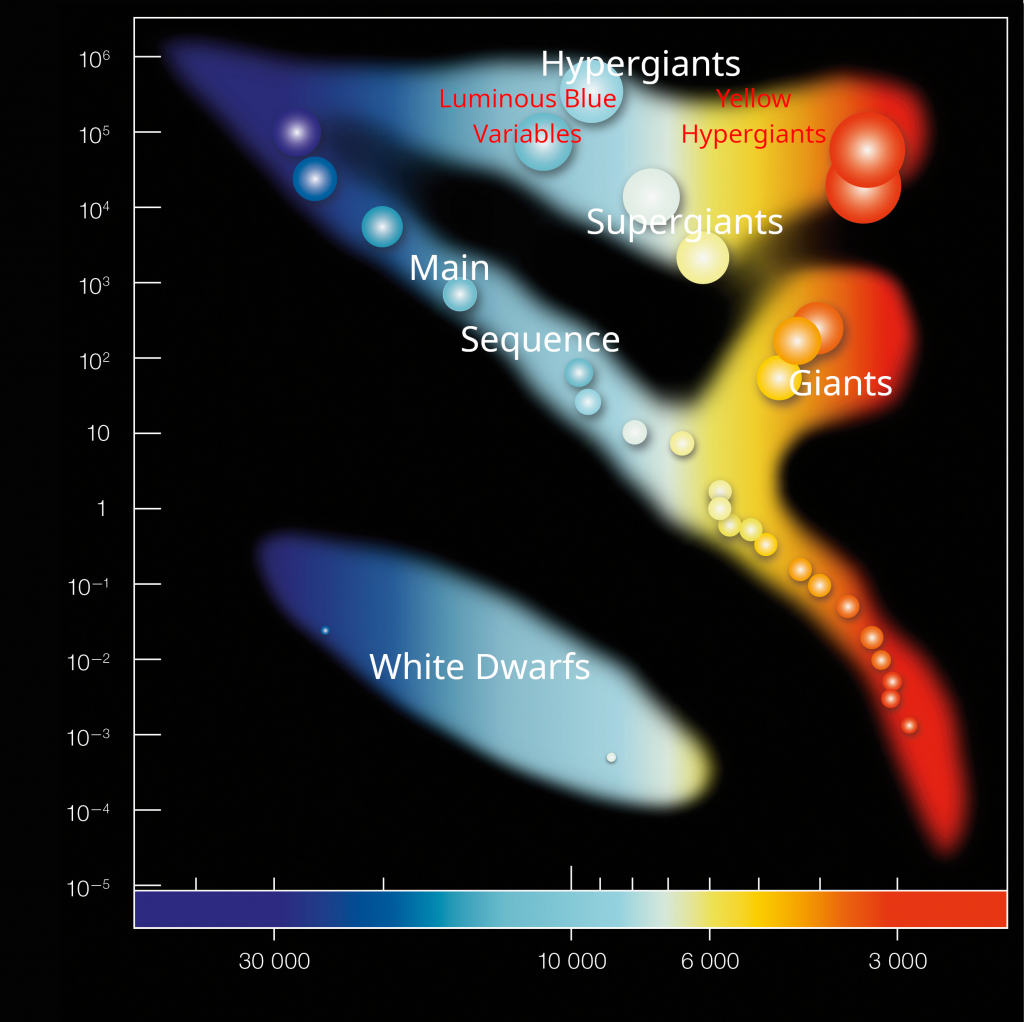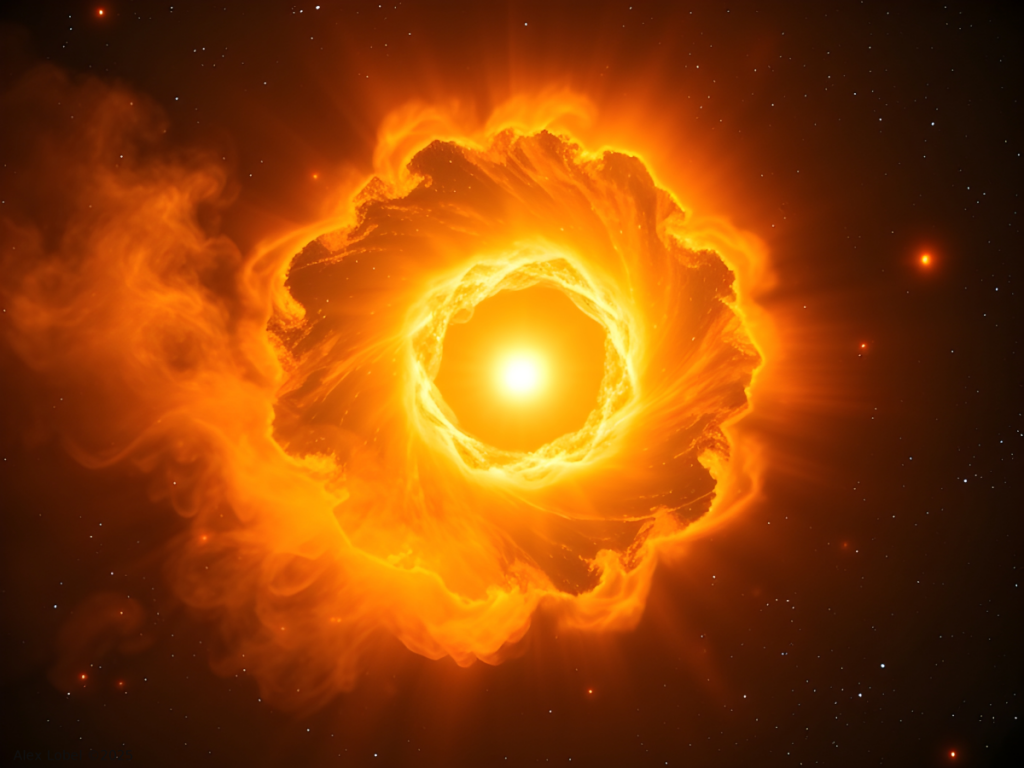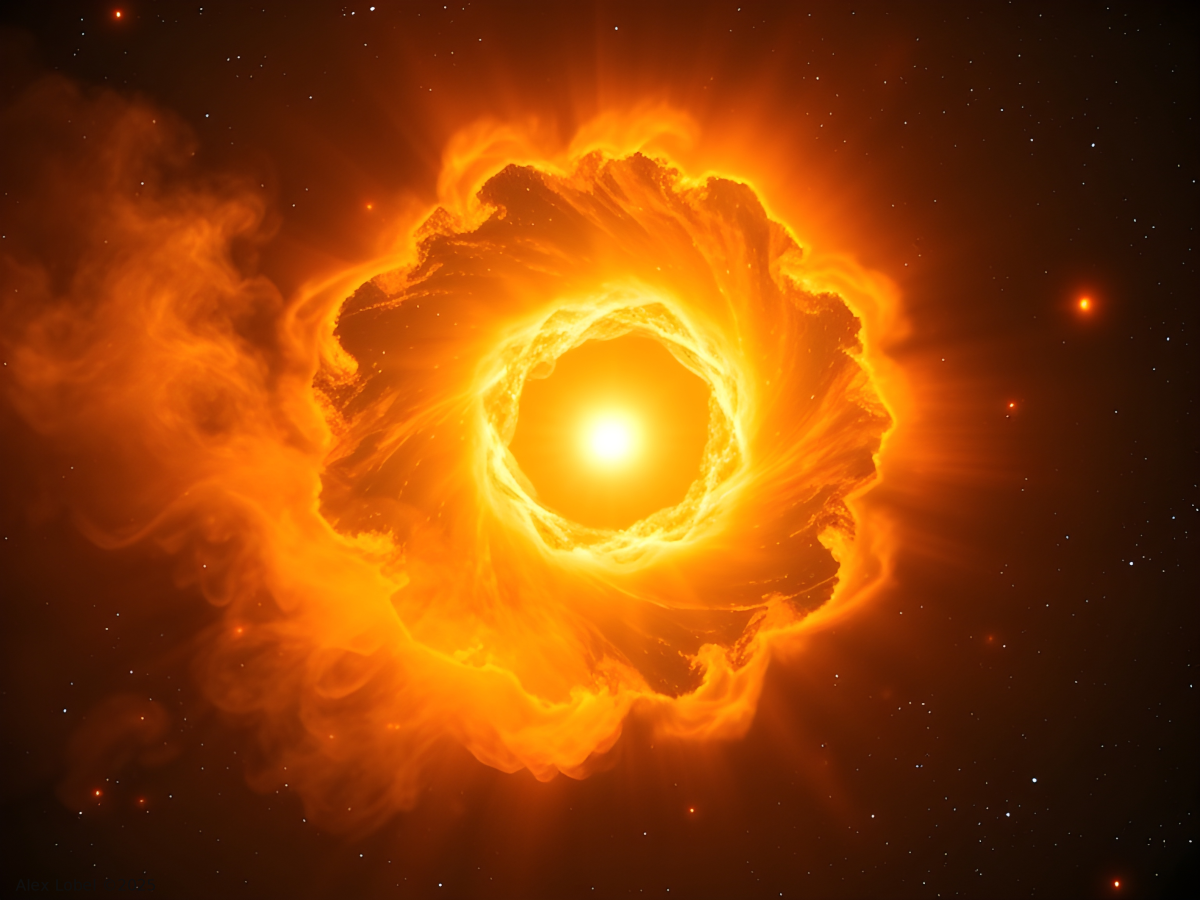New Insights into the Mysterious Yellow Hypergiant Stars Outbursts
Brussels, 17 February 2025 – A recent five-year study has uncovered new insights into the properties of Yellow Hypergiants, a heavy star class known for their dramatic outbursts. Scientists focused on Rho Cassiopeiae (Rho Cas), HR 8752, and HR 5171A, revealing that Rho Cas exhibits cyclical outbursts every 10 to 40 years, with large fluctuations of its surface temperature. Alex Lobel from the Royal Observatory of Belgium (ROB) was part of this international study that combined historical data covering 138 years. The results, published in Astronomy and Astrophysics, show that vigorous pulsations trigger these massive eruptions. They also offer a clearer understanding of the Yellow Hypergiants’ fast evolution and their potential transformation into Luminous Blue Variable stars or explosive supernovae.
Yellow Hypergiants
Hypergiants are among the most massive and luminous stars in our Galaxy. They show recurring and dramatic outburst events that have puzzled astronomers for decades. Important members are Rho Cassiopeiae, HR 8752, and HR 5171A. They are in the final stages of their fast evolution, offering unique insights into the life cycle of very heavy stars, having surface temperatures comparable to the Sun, but being up to half a million times more luminous.
The study of hypergiants offers astronomers a rare glimpse into the late life of massive stars. In particular, we get a look in the stage just before they evolve into core-collapse supernovae, or, alternatively, into a different class of hotter hypergiants called ‘Luminous Blue Variables’. This transition occurs when Yellow Hypergiants quickly evolve through the so-called Yellow Evolutionary Void in the upper Hertzsprung-Russell diagram of stellar temperature vs. luminosity. Understanding the recurring outbursts and pulsations of the Yellow Hypergiants helps astronomers to refine theoretical models of advanced stellar evolutionary stages and to improve understanding of cyclic stellar eruption phenomena.

Hertzprung-Russell diagram in which the temperatures of stars (horizontal axis) are plotted against their luminosities (vertical axis, measured comparing to the Sun in this diagram). The position of a star in the diagram provides information about its present stage and its mass. Stars that burn hydrogen into helium lie on the diagonal branch, the so-called main sequence of which the Sun is part. When a star exhausts all the hydrogen, it leaves the main sequence and becomes a red giant or a supergiant or hypergiant, depending on its mass. Stars with the mass of the Sun which have burnt all their fuel evolve finally into a white dwarf (left low corner). Some yellow supergiants will evolve into Luminous Blue Variables, hotter hypergiant stars that have the same luminosity range. Credit: ESO (annotated by L. B. S. Pham).
International Team
The new study, conducted over the last five years by an international team of scientists in The Netherlands (Leiden University), Belgium (ROB), and the UK (Durham University) also incorporates valuable data contributions from amateur astronomers worldwide. The team focused on Rho Cas, one of the most well-studied and naked-eye hypergiants, analysing the long-term brightness variability from 1885 to 2023. This extensive dataset allowed them to investigate its exceptional physical properties, as well as the onset and progression of three major atmospheric outburst events in 1986, 2000, and 2013.
These long-term observations reveal a fascinating pattern: Rho Cas exhibits cyclical atmospheric eruptions about every 10 to 40 years, each involving a significant fluctuation of the surface temperature, ranging from ~4500 to 7500 °C. The new findings provide a unique opportunity to follow a very massive star amid accelerated evolutionary changes.

Artist’s impression of the Yellow Hypergiant star Rho Cassiopeiae around which gas shells form due to recurring outbursts observed in the last 130 years. Credit: Alex Lobel. Source: https://brass.heliohost.org/alobel/rhocas/RhoCasArt2025.png
Hypergiant Outbursts
For the first time, the team calculated precise temperature calibration relations based on reliable spectroscopic data, combined with photometric observations between 1962 and 2020. This new methodology allows for a more accurate analysis of these extreme stars, in particular the dynamic behaviour of their huge atmospheres (Yellow Hypergiants have diameters of 400 to 700 times that of the Sun).
The study reveals that the pulsations of Rho Cas become more intense when approaching an outburst event. Specifically, the pulsation periods observed in the hypergiants’ V-band (or visible) brightness curve lengthen, and the pulsation amplitudes increase in the years leading up to an eruption event. This signals that strong radial pulsations play a crucial role in triggering recurring outbursts, which have occurred six times in the last 138 years, with time intervals of 10, 41, 40, 14, and 13 years. According to Dr. Lobel, co-author of this study: ‘It is the first time a thorough investigation was done with pretty much all of the available historical data of Rho Cas we collected from the literature, reaching far back to the 19th century. Moreover, we could combine with new observations including valuable contributions by amateur astronomers.’
A one minute video clip (animation) about the Yellow Hypergiant Rho Cassiopeiae can be viewed here in English, French and Dutch language. Credit: Alex Lobel (shared under a CC BY—NC-SA 4.0 International license). Source: https://brass.heliohost.org/alobel/pressrel2025.html
The research also investigated two other notorious Yellow Hypergiants, HR 8752 and HR 5171A. HR 8752 was found to evolve on a blue-ward evolutionary track after 1996, with its visual brightness staying nearly constant between 2017 and 2023. HR 5171A resumed its pulsation pattern in early 2018 after a period of gradual brightness decline.
The new study and observations are significant because they provide important insights in the sped-up evolution of Yellow Hypergiants. Overall, it not only improves our understanding of extreme stars, such as Rho Cas and its recurring eruptions, but also contributes to the broader knowledge of Yellow Hypergiants, their variability and importance for stellar evolution.
Publication
Astronomy & Astrophysics, 2025, 694, A136
https://doi.org/10.1051/0004-6361/202449384
Title:
Investigation of the pulsations, outbursts, and evolution of the Yellow Hypergiants: Rho Cas, HR 8752, HR 5171A, with notes on HD 179821
Authors:
M. van Genderen (1), A. Lobel (2), R. Timmerman (3, 4), E. R. Deul (1), A. Vos (1), H. Nieuwenhuijzen † (5), E. J. van Ballegoij (6), M. Sblewski (7), G. W. Henry (8), E. Blown (9), and G. Di Scala (10,11)
Affiliations:
(1) Leiden Observatory, Leiden University, Einsteinweg 55, Postbus 2333 CC Leiden, The Netherlands
(2) Royal Observatory of Belgium, Ringlaan 3, 1180 Brussels, Belgium,
(3) Centre for Extragalactic Astronomy, Department of Physics, Durham University, Durham DH1 3LE, UK
(4) Institute for Computational Cosmology, Department of Physics, Durham University, South Road, Durham DH1 3LE, UK
(5) SRON Laboratory for Space Research, Sorbonnelaan 2, 3584 CA Utrecht, The Netherlands
(6) KNWS Werkgroep Veranderlijke Sterren, De Rogge 6, 5384 XD Heesch, The Netherlands
(7) Esschenstrasze 36 in 15344 Strausburg, Germany
(8) Tennessee State University, Nashville, TN, 37200, USA
(9) 20 Cambridge Terrace, Masterton 5810, New Zealand
(10) Carner Hill Observatory, 9 Joshua Moore Drive, Horningsea Park, 2171, Sydney, Australia, and Astronomical Association of Queensland, Brisbane, Australia
(11) Astronomical Association of Queensland, Brisbane, Australia

